Welding of hdpe pipes: technologies, equipment and materials
In this article we will talk about how and with the use of what equipment, welding of HDPE pipes is performed. The topic of the article is relevant, as water and sewage systems assembled from polyethylene are becoming increasingly in demand.
And this is not surprising, since the price of polyethylene structures today is very attractive, even in comparison with the cost of polypropylene analogues. But before proceeding to the description of the welding process, let us consider what are the materials that we have to combine into a single water supply system.
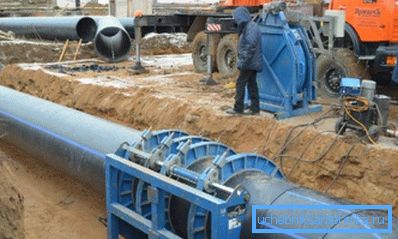
The main characteristics of the materials used
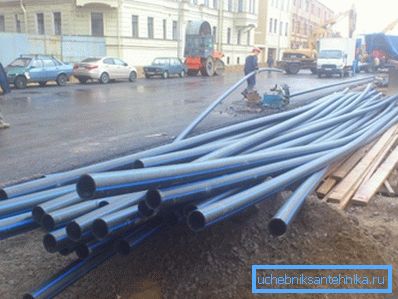
HDPE pipes are made of low pressure polyethylene, which ensures their resistance to mechanical loads in combination with elasticity.
This type of polyethylene pipes has found wide application in the construction of pressureless and pressure pipelines with a temperature of the transported medium not higher than +40? C. In addition, low-pressure polyethylene can be used for gas distribution and sewage communications, provided that the pipes are chemically resistant to transported media.
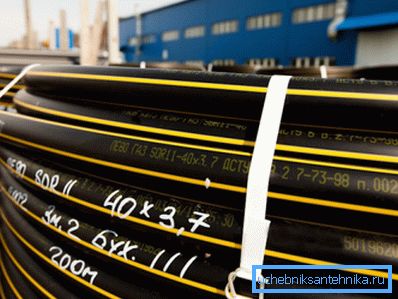
In the manufacture of HDPE pipes, PE80 and 100 grade polyethylene is used. Such materials comply with the requirements of GOST 18599-2001 (water supply device) and the requirements of GOST R 50838-2009 (gas pipeline construction).
To distinguish gas pipes from water allows marking and sideband. For water - the band is blue, and for gas - yellow.
Important: Gas pipes can be used for installation of gas and water supply systems. At the same time, the use of water pipes for transporting gas is unacceptable.
Low pressure polyethylene pipe is initially intended for underground installation, but if necessary it can be used for external installation. The product is sold in segments of 12 meters and bays of 100 and 200 meters.
Important: The pipe acquired in coils, long before the start of the weld, should be laid out on level ground for straightening.
The connection can be made in two ways:
- permanent connection by butt welding or using electrofusion;
- detachable connection using special compression fittings for pipes.
If the detachable connection can be used in the installation of water supply, then in the construction of gas supply systems, only butt-welding of pipes is allowed.
Butt Splicing Equipment
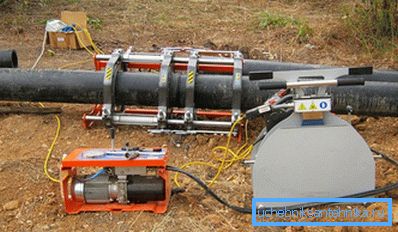
Equipment for welding PND butt-end pipes is represented by machines for work in stationary or field conditions. Both those and other modifications consist of a frame (bed), on which centering clamps are located, allowing longitudinal movement of the parts to be soldered.
The equipment is equipped with a heating element, the perimeter of which repeats the external diameter of the pipes. In addition, the kit includes a device for aligning the ends. This is a mechanical tool that simultaneously aligns both ends.
Stationary devices, as a rule, are fully mechanized and the movement of pipes along the frame is carried out by means of jacks. Some mobile machines suggest the need for manual movement of soldered elements.
Butt Welding Technology

Such welding of HDPE pipes with their own hands is relevant for building systems with a diameter of 50 mm and more.
Tip: As already mentioned, to perform a butt joint you will need a welding machine, the price of which is high. Therefore, such equipment is used by professionals, while novice plumbers can rent a high-tech device.
The technology of joining polyethylene products end-to-end is to heat the end cuts to the melting point and to docking under pressure. The strength of the seam obtained is sufficient for the long-term operation of the joint obtained, but with the proviso that this joint will be used stationary.
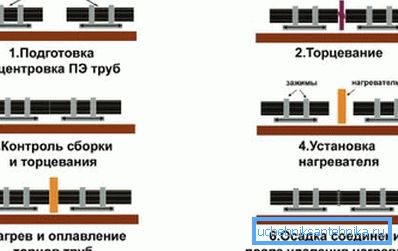
Butt welding instructions are as follows:
- The ends of the pipes are cut at a right angle and fit into the machine so that one end is located opposite the other;
- Further, the welded elements are fixed by metal grippers. (two centering clamps on each side) in the position in which they will be soldered;
- Between the ends of the device is installed, leveling the ends of the pipes at a right angle;
- Then between the aligned ends the heating element is installed., which heats the perimeter of polyethylene pipes to the working temperature;
- Next, the heating element is removed, and molten ends are pressed for 2-3 minutes under high pressure;
- After the polymer material has cooled, the joint is not only high in strength, but also in aesthetics of the seam.
Electrofusion welding
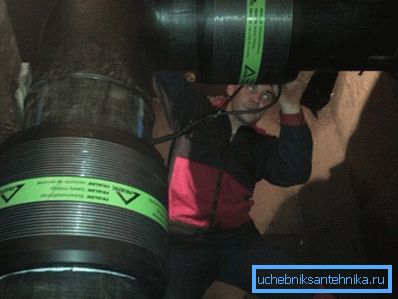
This technological process allows to collect polyethylene pipes in a single system, taking into account the high strength of the connection. The instruction of welding works is simple and allows the possibility of doing it yourself, without the need for the services of professional specialists.
The principle of connecting two pipes into a single whole consists in applying voltage to a spiral fused into a pipe coupling. Due to this, the coupling heats up to the required temperature and melts. In order to melt the polymer coupling, a special apparatus is used, which supplies the required voltage to the shaped element.
Among the advantages of the technology, the following should be noted:
- ease of implementation of welding in comparison with machines butt-soldering;
- higher resistance to mechanical deformation in comparison with the butt joint;
- small standard sizes and weight of the machine that allows to carry out works in field conditions;
- the possibility of soldering joints with a small intermediate gap.
The technology of electrofusion welding
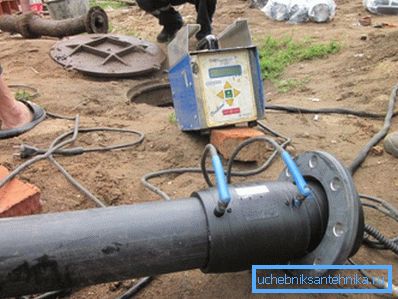
- Polyethylene pipes are located at the same level relative to each other. If there are special adjustable guide stands in the set, we use them; if not, we manage with improvised means.
- Cut the ends with a special cutter, which provides the possibility of cutting at an angle of 90 ?.
Important: You can not cut the pipe with a knife or saw, because it will not be possible to achieve optimal quality and evenness of the cut.
- Using a lint-free rag and an alcohol-based degreaser, carefully wipe the ends on the outside and on the inside.
- On each of the pipes, we measure a distance from the end equal to half of the coupling and mark it with a special white marker.
- Over the entire measured distance we remove the surface layer. For these purposes, we use a special scraper, which is included in the welding machine package.
Important: In no case should such work be performed using sandpaper, as individual grains of abrasive in polyethylene will make the soldering untight.
- On the measured edge, where the coupling will end, we install a special clamp, which subsequently will allow to position the pipe.
- The cleaned part of the pipe is degreased.
- We install the coupling on both ends and turn on the equipment for welding HDPE pipes. The soldering lasts about 4 minutes, while it takes about 10 minutes to cool the plastic.
Conclusion
As you could see, making the connection of HDPE pipes with your own hands is not that difficult if you have the appropriate equipment. More useful information that is useful during installation, you can find by watching the video in this article.